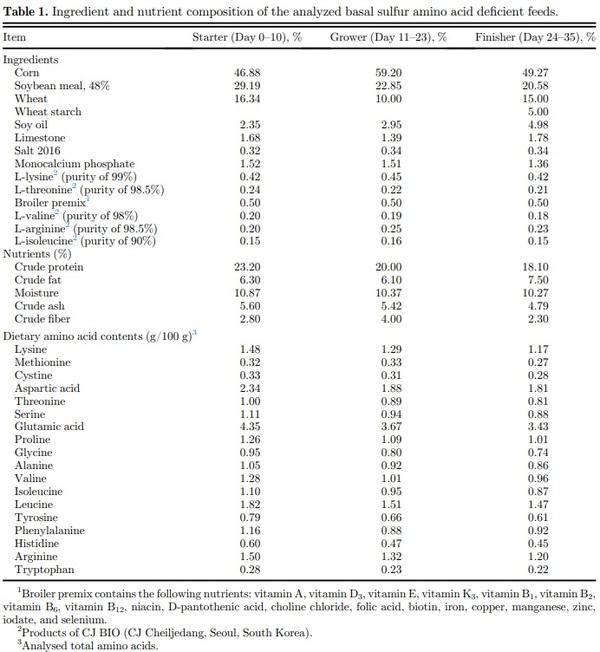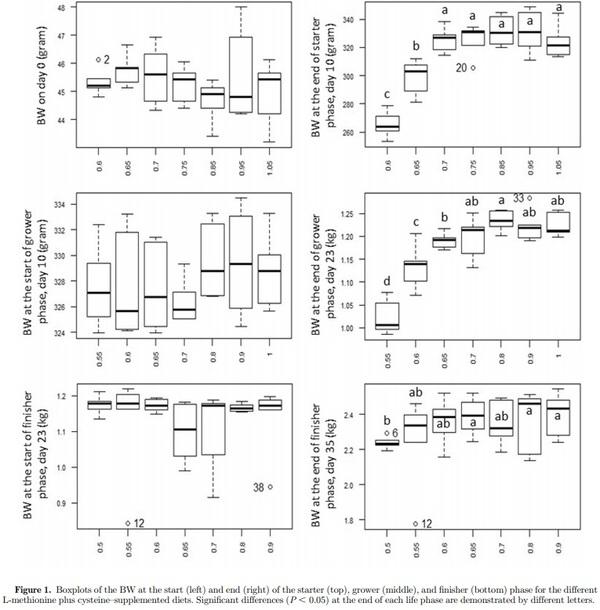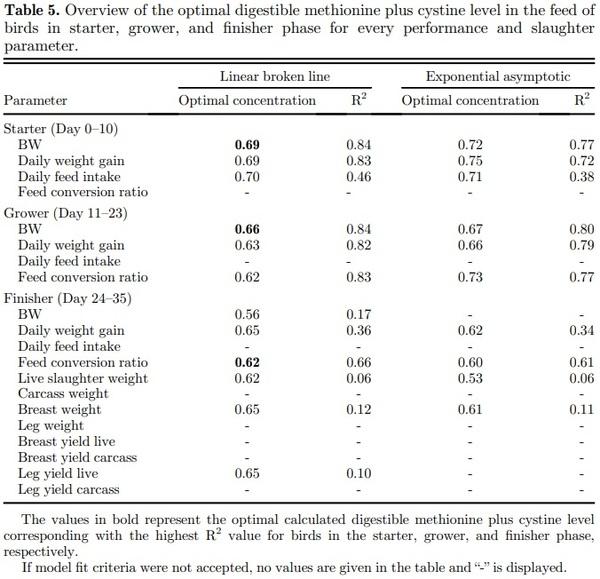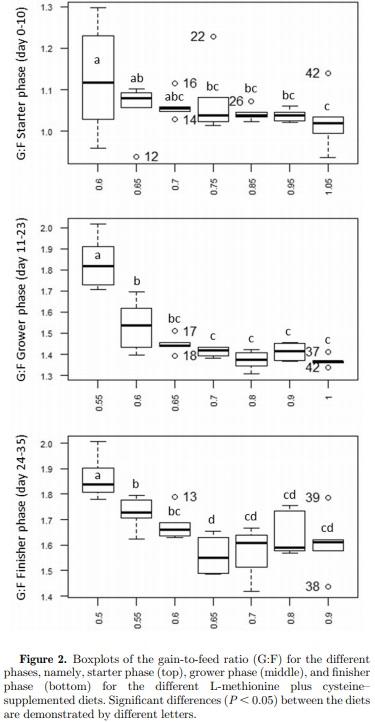INTRODUCTION
The suggested BW of broilers (ROSS 308) will increase 50- to 55-fold at the age of 35 d as compared with the day-old chick weight (Aviagen, 2019a). Correct supplementation of dietary amino acids is crucial to support the exponential growth of broilers. Methionine (Met) is the first limiting amino acid in broilers; thus, meeting the requirements of Met plus cystine is crucial.
The inclusion level of Met is increasing continuously in commercial broiler diets owing to a crude protein reduction trend. Oversupply of amino acids will cause extra excretion of nitrogen, and the purpose of reducing environmental impact due to animal production will not be supported. Under the present circumstances, there is a need for updating the requirement of sulfur amino acids (SAA) in poultry.
The majority of SAA recommendation studies used DL-Met to create the different dietary concentrations of SAA because L-Met was not available as a registered feed additive at that time (Jensen et al., 1989; Dozier and Mercier, 2013; Faridi et al., 2016). Likewise, several standard feeding guidelines suggesting the requirements of SAA in broilers are also based on DL-Met. Variations in SAA recommendations are observed both in the literature and between breeding companies. For example,

Jensen et al. (1989) suggested a minimum SAA requirement of 0.78% for 3- to 6-wk-old broilers, which is higher than the recommendation of 0.72% from the NRC (Jensen et al., 1989; National Research Council, 1994). On the other hand, Lumpkins et al. (2007) assumed an optimal requirement of 0.72% for the same age category, thus corresponding really well with the NRC values. Commercially, the Ross 308 recommendations suggest to use 0.95, 0.87, and 0.80% standardized ileal digestible Met plus Cys for the starter, grower, and finisher phase, respectively (Aviagen, 2019b). But, in case of Cobb 500, the recommendations are 0.88, 0.80, and 0.74 in starter, grower, and finisher phases. It should be noted that SAA requirements have been found to vary depending on sex, growth criteria, rearing environments, and processing yield (Lumpkins et al., 2007). Nowadays, Met is available in 2 isomer forms and can either be supplemented as DL-Met (50% D-Met and 50% L-Met) or pure L-Met. Physiologically, animal cells can only use the L-isomers of amino acids, and every D-isomer


should be converted to the corresponding L-isomer before being used in protein synthesis. If a bird consumes DLMet, only 50% is directly available as L-Met, whereas the other 50% should be converted first. Theoretically, supplementation of pure L-Met in the feed should lead to more efficient absorption and protein synthesis. There is however still a lot unclear with regard to the conversion process of D- to L-Met, the efficiency of this process, and the effect on performance of broilers (Esteve-Garcia and Khan, 2018). For example, broilers fed from 0 to 35 d with either LMet– or DL-Met–supplemented diets as per their current SAA requirement level did not show any differences in performance or slaughter yield (Zhang et al., 2017). On the other hand, Shen et al., 2015, Park et al., 2018, and Esteve-Garcia and Khan, 2018 found L-Met to have a higher relative bioavailability than DL-Met, and they also observed an improvement in intestinal redox status and development of gut morphology. The compelling difference in requirement standards for SAA requirements are thus attributed to not only the genetics, age, sex, and production targets but also the source of Met. Taking into account the scarcity of the literature concerning SAA requirements of broilers determined in diets supplemented with L-Met, the present study was designed to re-evaluate the optimal SAA requirements of broilers in the starter, grower, and finisher phases separately using L-Met supplementation.
MATERIALS AND METHODS
Animals and Housing
A total of 1,890 male broilers (Ross308) were housed in the test facility (Poulpharm Bvba, Izegem, BE). Birds arrived as 1-day-old chickens and were either placed in 1 m2 pens or in a large pen of 42 m2, depending on the life phase in which the birds were included, namely, starter, grower, or finisher phase. Care and use of animals was in accordance with the principles and guidelines presented in Guide for the Care and Use of Agricultural Animals and Research and Teaching (Federation of Animal Sciences Societies, 2010).
Study Design
In this trial, 7 treatment groups were included in each phase of broiler life, namely, starter (Day 0–10), grower (Day 11–23), and finisher (Day 24–35) phase. Six replicates were used for every treatment group containing 15 birds per replicate. Upon arrival at the test facility, 630 birds were divided over 42 small pens, whereas the other 1,260 birds were placed in 2 large pens (pool birds). Birds housed in small pens were fed with the test starter diets, and birds in the pool were fed with a commercial starter diet. On study day 10, birds housed in the small pens were weighed per pen and removed. Six hundred thirty birds from the pool who were fed with the commercial starter diet during the first 10 d of trial were now selected, weighed, and placed in the small pens. The grower test diets were given to the birds in the small pens from day 10 until day 23. On study day 23, similar to day 10, birds housed in the small pens were weighed per pen and removed. The remaining 630 birds from the pool, that ate a commercial starter and grower diet, were now transferred to the small pens to be fed with the finisher test diets. Birds leaving and entering the small pens were weighed per pen. With every bird switch, the pen weight of the new included birds was within acceptable margins of the mean pen weight of the first 5 allocated pens. On day 10, all pen weights were not smaller or greater than 2 standard deviations of the mean pen weight of the first 5 pens. On day 23, inclusion was set at one standard deviation from the mean pen weight. Finally, on study day 35, all birds in the small pens on the test diets were weighed per pen, and the slaughter yield of 4 random animals per pen was determined.

Evaluation Parameters
Daily health observations were performed, and mortalities or birds that had to be culled owing to welfare reasons were recorded. Standard performance parameters were followed for the birds included in the starter, grower, and finisher phase, namely, ADG, ADFI, BW, and gain-to-feed ratio (G:F). At slaughter, the live weight, carcass weight, breast meat weight, and leg weight were measured. With these parameters, the breast meat yield and leg weight yield could be calculated.
Test Diets
One basal SAA-deficient feed was produced for the starter, grower, and finisher phases, respectively
(Table 1). L-Met (purity of 99%) was then supplemented to obtain concentrations of digestible Met plus Cys as specified in Table 2. Finally, all the feeds were pelletized before packing in bags. Feed samples of every test diet were taken to perform a Weende analysis and to determine the total protein bound and free amino acids (CBA GmbH Boehlen, R€otha, Germany). All amino acids were procured from CJ Europe GmbH (Frankfurt, DE).
Statistical Analysis
Data were analyzed using R (R Core Team, 2020). Mortality was analyzed using a Cox proportional hazards model (Therneau and Grambsch, 2000). Significant differences (P < 0.05) in performance and slaughter parameters were analyzed using linear regression models (procedure lm of the core package). Post hoc least significance difference tests were performed with no adjustment for multiple comparisons. Two models were fit for every performance and slaughter parameter to determine the optimal level of SAA, namely, a linear broken line and an exponential asymptotic model. Model selection was based on the following criteria: if no significant differences were observed in the categorical model, this means that this parameter is not influenced by varying L-Met plus Cys levels; if conditions for good model fit were not met, the model was neglected; finally, the model with the highest R2 value was selected. Both models are outlined below.

In the linear broken line model, Y is the outcome variable; X is the measured concentration of the feed component; α is the estimated maximum performance; β is the estimated increase in performance per concentration until the threshold value after which performance no longer increases; θ = estimated threshold concentration value – (concentration-theta) = 0, for x > theta; and error is the error term, namely the difference between estimated and observed performance.
The models were fit with the procedure lm.br of the package lm.br published by Adams (2017) and following the method described by Knowles et al. (1991). Theta was considered as the optimal concentration. If 1 or - infinite lied in the 95% confidence interval of theta, the broken line model has a poor fit and was no longer considered relevant.
In the exponential asymptotic model, Y is the outcome variable, X is the measured concentration of the feed component, c is the lower limit (performance at concentration 0), d is the upper limit (maximum performance), and e is the parameter determining the steepness of the increase in performance by concentration.
The exponential models were fit with the procedure drm (function AR.3 of the package drc, Ritz et al., 2015). The concentration at which 95% of the maximum performance in the studied range of concentrations was reached was considered the optimal concentration. If “e,” indicating the steepness of the curve of the exponential asymptotic models, was nonsignificant (P > 0.05), the model fit was poor and that model was no longer considered relevant.
RESULTS
Broiler Performance and Slaughter Parameters
An overview of the performance parameters of broilers fed with the test diets in the different life phases is
summarized in Table 3. No differences in general health behavior or percentage mortality were observed. The LMet level in feed had a significant (P < 0.05) impact on BW, ADG, ADFI, and G:F in all 3 life phases. Only ADFI was not significantly different between birds in the finisher phase. Figure 1 demonstrates the differences in BW at the start and end of every life phase, and Figure 2 demonstrates G:F in the starter, grower, and finisher phase. An overview of differences in slaughter parameters for the birds fed with the finisher test diets at the end of the study period (Day 35) can be found in Table 4.
Optimal Digestible L-Met Plus Cystine Levels
Linear broken line and exponential asymptotic models were fit for every performance and slaughter parameter. Outliers were defined as values higher or lower than 1.5 times the interquartile range of the boxplot and were not included in the analysis. An overview of the different models, their fit, and the associated optimal digestible Met plus Cys level is demonstrated in Table 5. Overall, the linear broken line model demonstrated the best fit. The optimal digestible Met plus Cys concentration was different for each performance and slaughter parameter. Selection of the digestible Met plus Cys concentration based on model fit criteria and the highest R2 value led to optimal concentrations of 0.69, 0.66, and 0.62% for birds in the starter, grower, and finisher phase, respectively.
Feed Composition
The results of analysis of all test diets and the commercial diets can be found in the supplemental material (Supplementary Tables 1–5).
DISCUSSION The results of the current trial suggest an optimal digestible Met plus Cys concentration of 0.69, 0.66, and 0.62% for broilers in the starter, grower, and finisher phase, respectively, when the source of the Met consists of pure L-Met. The linear broken line model demonstrated the best fit with the different measured parameters. Moreover, in the starter and grower phase, the best fit was obtained based on BW, whereas the finisher phase demonstrated the best fit with G:F. Regarding BW, it seemed as if birds in the starter and grower phase were much more sensitive to the correct digestible Met plus Cys supplementation level than birds in the finisher phase. Indeed, correct supplementation of SAA in broiler diets is crucial for optimum performance, whereas supplementation at levels lower than the requirements led to loss of overall performance, which was also demonstrated in several trials (Jensen et al., 1989; Dozier and Mercier, 2013; Faridi et al., 2016; Zhang et al., 2017; Esteve-Garcia and Khan, 2018). Supplementation of SAA or other essential amino acids at levels higher than the requirements will not necessarily have a negative impact on broiler performance, but they do have an economic impact because this will lead to an additional unnecessary feed cost. Moreover, oversupply of amino acids might have an environmental impact as the nitrogen excretion of broilers will increase (Belloir et al., 2017).

L-Met supplementation at different concentrations had a significant impact on performance parameters. Esteve-Garcia and Khan (2018) also demonstrated a steady increase in BW, ADG, and ADFI and decrease in G:F in broilers fed with diets with continuous increase in concentration of dietary DL-Met or L-Met. Although the effect on performance in the starter and grower phase was clearly visible, the effect on performance and slaughter yield of birds in the finisher phase was more limited in the present study. This might be attributed to the fact that in the current trial, fresh birds were used for every life phase, whereas birds in the study of Esteve-Garcia and Khan (2018) were fed with the test diets from birth until the end of the growth period.
Two models were each time fit for every parameter to evaluate the optimal digestible Met plus Cys concentration. The linear broken line model was found to be the most appropriate model based on the different model fit criteria and R2 value. The calculated value based on these models represents the optimal digestible Met plus Cys level at which maximum performance for that specific parameter was reached. Inclusion of less L-Met than the predicted level would lead to loss of performance. Inclusion of more L-Met would not lead to an extra gain in performance. The predicted optimal concentration in the starter phase was quite consistent between the different performance parameters, namely, 0.69%. The grower and finisher phases were characterized by an optimal digestible Met plus Cys concentration of 0.66 and 0.62%, respectively. However, the exact inclusion level might vary depending on the parameter of interest or a combination of performance parameters. For example, in the finisher phase, based solely on BW, 0.56% digestible Met plus Cys could be sufficient. However, when also taken G:F into account, it might be better to have an inclusion level of 0.62%. Hence, this will lead to the more ideal combination of higher BW and lower G:F. For birds in the grower phase, the ideal concentration would then be 0.66%.
It should be noted that the inclusion levels determined in the present study are lower than those in the current guidelines and literature that are based on supplementation with DL-Met (Jensen et al., 1989; Federation of Animal Sciences Societies, 2010; Aviagen, 2019a,b). This might be due to the stereochemical properties of Met. Lerner and Taylor (1967) already reported differences in absorption of the 2 isomers with a preference for the L-isomer. Moreover, the Met source can alter the rate of absorption and expression of transporters not only for itself but also for other dietary components (Mastrototaro et al., 2016; Jankowski et al., 2017; Zhang et al., 2017). Next to selective absorption, biotransformation of D-Met to L-Met is also no longer needed when L-Met is supplemented in the feed (Zhang et al., 2015). Even the distribution and excretion of L-Met was proven to be different compared with DL-Met and DL-2-hydroxy 4-methylthiobutanoic acid (Saunderson, 1985, 1987). Absorption, biotransformation, and the final protein synthesis and excretion are complex processes that can be influenced by a variety of factors (Mastrototaro et al., 2016). Although lower optimal inclusion levels were observed in the present study, no exact comparison with DL-Met or other Met analogs could be made.
In conclusion, when Met is administered as the L-isomer, optimal inclusion levels seem to be lower for the starter, grower, and finisher phases than current guidelines and literature. This deviation might be attributed to some extent to a higher relative bioavailability of LMet than DL-Met. Other factors could not be excluded in the present study. Nevertheless, more extensive research is required to confirm these findings.
This article was originally published in 2021 Poultry Science 100:910–917. https://doi.org/10.1016/j.psj.2020.11.023. This is an Open Access article licensed under a Creative Commons Attribution License. 
















_1.jpg&w=3840&q=75)